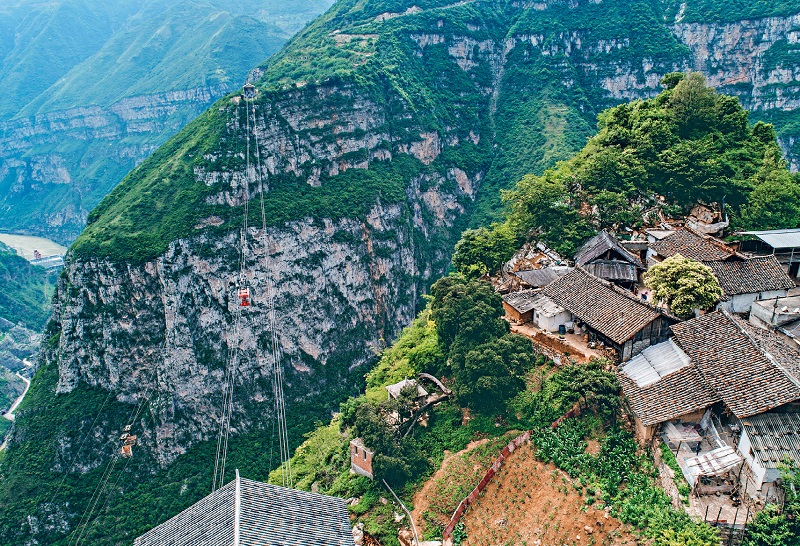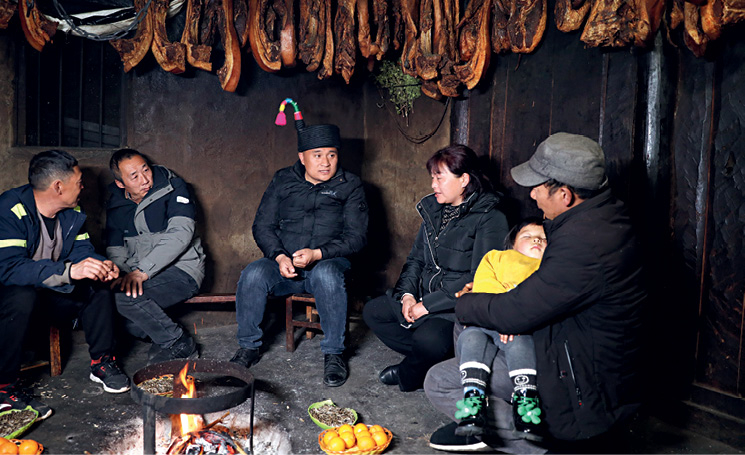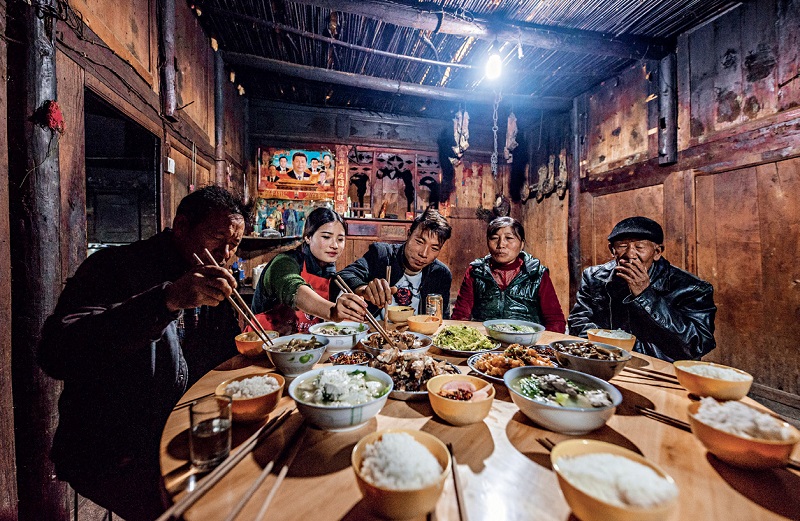
In the early morning on February 24, Zheng Wangchun, who was a deputy to the 14th National People’s Congress (NPC) and also the village committee director, sat down with his village committee colleagues and residents to listen to their suggestions, before departing for Beijing to attend the “two sessions.” It’s a three-hour round trip on foot between Zheng’s home and the village committee meeting venue over a narrow path built on a steep cliff. The trail is about five kilometers long, with a vertical height of nearly 1,000 meters. Meanwhile the road is only one meter wide and has many steep slopes, making it difficult trekking up and down.
Gulu Village is located on a steep cliff at the entrance of the Grand Canyon of the Dadu River in Yongli Township, Hanyuan County in southwest China’s Sichuan Province, and is known as “the village on the ladder to heaven” or “the village on the cliff,” because in the early years villagers made the climb and descent using a vine ladder.
Gulu, with a population of 680, is the farthest village of the Yi ethnic group from the county seat in Hanyuan. Much effort has been made to improve the local transport. In 2003, under the direction of the village committee, villagers chiseled out a Z-shaped trail on the cliff, which gave the village more connection with the outside world. In 2016, the local government invested more than RMB 24 million in building a 760-meter-long cable car route, which became operational two years later, marking the end of Gulu’s isolation from the world and making it a trendy tourist attraction. In 2018, the village was lifted out of poverty by virtue of its emerging rural tourism industry.

Zheng Wangchun and Luo Yunlian visiting a local villager’s home and listening to their advice on village development.
Diversified Local Economy
Ten years ago, Luo Yunlian, then Party secretary of Gulu Village, was elected a deputy to the 12th NPC. Under her leadership, a cable route was built in the region, and the travel time was shortened from three hours to three minutes. Better access to the outside world helped development of local green industries. Residents grew spicy Sichuan pepper and walnuts around their houses. “There are more and more tourists coming to our village, so we encourage and help local villagers to operate family-run hostels,” said Luo, adding that Gulu had also become a model of poverty eradication in Sichuan Province for its economic progress.
On March 8, 2017, when President Xi Jinping, also general secretary of the Communist Party of China (CPC) Central Committee, attended the deliberations of the Sichuan delegation at the fifth session of the 12th NPC, Luo shared with him the changes that had taken place in her village after the poverty eradication campaign was launched. “The general secretary told us that the key to poverty eradication was to make targeted measures and also to get everyone motivated.” Today, Gulu has found its own path of poverty eradication and rural revitalization, featuring integrated development of ecology and ethnic culture.
Zheng Wangchun is both a witness and an enabler of the dramatic changes in Gulu Village. In 2012, he quit his well-paid job in Shenzhen, and returned home with a group of young people from his village. They started to develop rural tourism by setting up a family-run hostel. Because of his exceptional management skills and financial knowledge, he was elected as the deputy director of the village committee, and in 2020 the Party secretary of the village and director of the village committee.
After succeeding Luo Yunlian as the village leader, Zheng promoted rural tourism as a breakthrough for sustainable development. In two years, he led the villagers in building a visitor reception center, ecological parking lot, ethnic culture square, Dadu River viewing platform and other facilities. In order to improve the tourism industry, he invited experts from the county to give villagers hands-on training, which resulted in improved services which attracted more tourists. This year, they will launch family-friendly tours, intangible heritage experience tours, and other tourism projects, upgrading the “one-day sightseeing tour” to a “multi-day experience tour.” Gulu is a village with hundreds of years of history where tourists can experience traditional Yi culture while enjoying the magnificent canyon scenery. “Our traditional Yi culture will also be better inherited with the help of tourism,” he said.
Over the past two years, new roads were built, streetlights installed, around 100 hectares of spicy Sichuan pepper, walnuts, red plums, and herbal medicine planted. Meanwhile the number of homestays in the village increased to 21. Through these efforts, local economy became diversified, and per capita income increased year after year. “This year we want to apply for the national 3A tourist attraction qualification, so that rural tourism in Gulu could be a sustainable industry,” said Zheng.
The “New Life” of Gulu Village
Lan Mingxiang, 92, moved to Gulu village at the age of 16 and had not been down the mountain for decades. “In the past, because of travel difficulties, many elderly people had not left the mountain after moving up to the village,” said Zheng. At the bottom of the old vine ladder was the turbulent Dadu River, which posed a threat to the children climbers. After the opening of the cable service in 2018, old Lan went down the mountain and visited her hometown for the first time since she moved to Gulu. “The old lady told me that she had never dreamed that Gulu Village would have developed so well, and wished she could live for a few more decades to enjoy the new village life,” Zheng recalled.
Gulu’s improved facilities have not only invigorated the local tourism economy, but also brought a new mode of development. The 50-year-old villager Shen Shaohua was the first to start a homestay business in the village. At first, he only catered for tourists with simple meals, but later as numbers increased, he renovated his family’s old house and expanded it. Now, during high season, all the eight bedrooms in his house are fully booked every day. His son and daughter-in-law, who had worked outside Gulu for years, also returned to run the family business together. Today, Shen’s income from tourism can reach RMB 100,000 to 200,000 every year.
Shen said that in 2013, due to poor transportation conditions, the renovation of the old house cost him RMB 150,000, and RMB 100,000 of that was used to transport construction materials. “With the cable service, however, the cost is now only about RMB 20,000 for carrying the same materials,” said Shen.
Seeing the success of the tourism industry in the village, many young people who left for greener pastures in the urban areas have returned to start their own businesses. “In recent years, after the courier and Wi-Fi services became available in the village, a lot of young people began to sell goods through livestreaming. Products like Yi embroidery, walnuts, Sichuan pepper, bacon, goat meat, wild honey and other specialties are sold to people in all parts of the country.”

Homestay host Shen Shaohua’s family members are having dinner at home in Gulu Village. Li Yifan
Achieving Greater Development through Protection
The protection and development plan of Gulu Village has had its critics. Some people said that instead of a RMB 24 million investment into a cable facility, it would be better to rebuild the village in a more accessible location out of the mountain; while others said that the money spent on the cable car would create more value if it was divided among villagers. In response, Zheng said, “The traditional culture can not be restored once the ancient village declines, while their culture has been the root of the Yi people’s life for generations.”
Meanwhile Gulu has gone on to become an iconic attraction for the local rural tourism, and its fame drives tourism in its surrounding areas.
Xiao Fang, a well-known folklore expert from Beijing Normal University, said that the work of fostering tourism economy through protection and development of Gulu Village is still at the primary stage. He suggested that rural tourism in Gulu has its own unique style, and in the future the village would not only display traditional Yi culture, but also provide a series of other enjoyable activities such as painting, handicrafts, and canyon trips, “So that the ancient village would exude lasting mystery and attraction.”
“During this session of the National People’s Congress, I am most concerned about the country’s initiatives in promoting rural revitalization,” said Zheng. For the development of Gulu Village, Zheng believes that local industries should be developed without affecting the ancient village’s uniqueness. Looking at the big picture, plans are made to improve the living environment, repair old houses, and upgrade family-run hostels, so as to let agriculture and tourism continue to develop hand in hand.